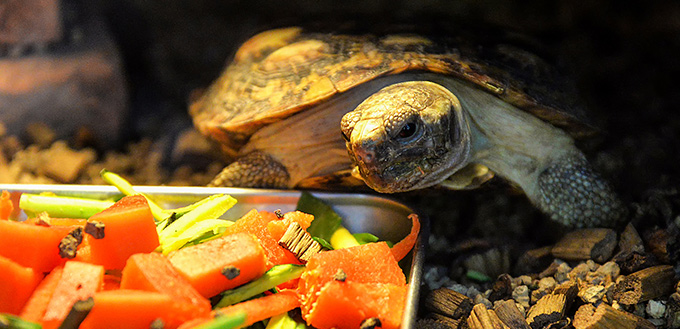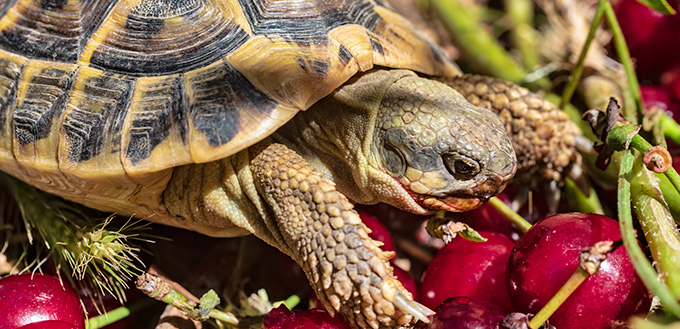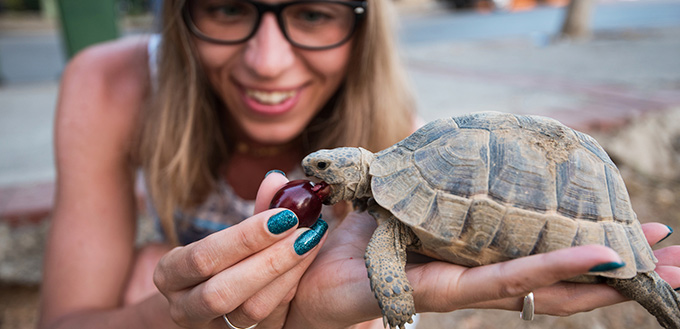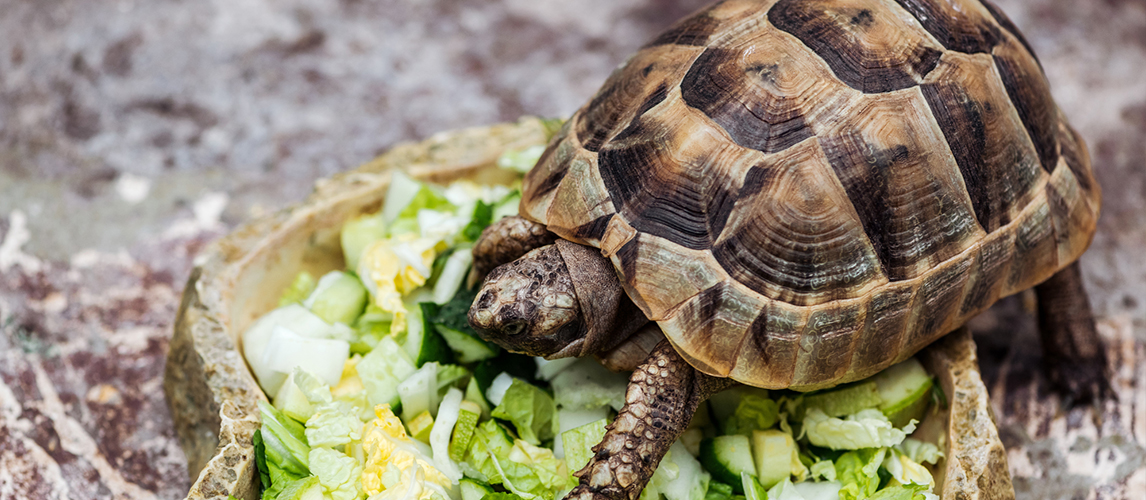Turtles are fairly uncommon pets when compared to dogs and cats, and this can mean that seemingly basic information, such as feeding, is not very widely known. This is often the first hurdle to overcome when you have a new, unusual pet. You need to do plenty of research to make sure you will have access to all the resources your new family member will need. As we believe in being as useful as possible to all pet owners, here is a guide for feeding a pet turtle.

Turtle Nutrients
The first thing you need to know about any pet is what they eat and what their body needs. To do this for a turtle, it helps to know that they are either omnivores or carnivores. Incidentally, this is one of the key differences between turtles and their similar-looking, land-dwelling friends, the tortoise. Tortoises cannot eat animal matter, so are herbivores.
If you aren’t sure whether your turtle is carnivorous or omnivorous, the general rule is that aquatic turtles are more carnivorous than semi aquatic turtles. This means:
- Aquatic turtles need between 65% to 90% animal matter, like meat, and 10% to 35% plant matter, such as vegetables.
- Semi aquatic turtles need a more even balance, consuming 50% animal matter and 50% plant matter.
All turtles will need a different combination of their essential building blocks of nutrition: protein, fat, fibre, minerals and vitamins. Wild turtles will get this nutrition through catching worms, small insects, snails, and small fish when young, and increasing their consumption of surrounding vegetation as they become older. You must do your best to simulate that in captivity.
As with most animal, nutritional needs change over time, and you must be aware that young turtles will need more protein to support their growth while older turtles may have a reduced need for calories. Ultimately, the best food for turtles will meet the nutritional requirements of their age, sex, breed, and size.
Feeding My Turtle
While we cannot possibly list every possible combination of your turtle’s age, sex, breed and size, we can give you some guidelines for what to feed your turtle. There are many foods that can meet their nutrition requirements, but you will need a mix of these foods to create a balanced diet. Foods that you can consider include:
- Commercial pellet food made for turtles
- Feeder fish
- Comet goldfish
- Insects
- Mealworms
- Slugs
- Live crickets
- Earthworms
- Snails
- Mollusks
- Worms
- Frozen pinkie mice
- Kale
- Collard
- Mustard greens
- Dandelion greens
- Cabbage, in small quantities
- Endive
- Parsley, in small quantities
- Flower heads
- Clover
- Shredded carrots
- Squash
- Zucchini
- Peas
- Parsnips
- Red or green peppers
- Sweet potatoes
- Green beans
- Water lettuce
- Water hyacinth
- Duckweed
- Shredded apple, without any seeds
- Shredded melon
- Chopped berries
- Cantaloupe
- Mango, without the pit
Pellets are particularly important as a foundation for your turtle’s diet. They are specifically designed to provide a healthy balance of nutrients, and they are designed to float for aquatic feeding. However, they should not be completely relied upon. You still need additional protein and vegetable matter.
Essentially, you should provide a balanced mixture of pellets, feeder fish, insects, dark leafy greens, other vegetables, and a bit of fruit. These proportions will be determined by the breed and characteristics of your turtle, but it is worth noting that no breed of turtle should have a lot of fruit. Fruit should be considered a treat due to their high sugar content.

You also need to use supplements of essential minerals and vitamins to support your turtles health. In particular, your turtle needs calcium, but there are other supplements that you can additionally use, such as Vitamin A. The best method to do this is to coat the vegetables and fruit that you give your turtle with powdered supplements. You do this by:
- Putting several scoops of the supplement powder in a plastic bag
- Adding the fruit or vegetables to this plastic bag
- Shaking the bag until the food is completely coated in the powder
- Serving this to your turtle
So to help you put all this information together, here is the example of the red-eared slider, the most common breed of pet turtle in the United States. They are an aquatic turtle that eats an omnivorous diet. An adult red slider requires 25% commercial pellets, 25% protein, and 50% vegetables and fruit. You would then ensure that the vegetables and fruit are coated in essential minerals and vitamins before serving this diet to them.
How Much Should You Feed Your Turtle?
Now that you know what to feed them, you need to know how much to feed a turtle. Unfortunately, just as above, this is not completely simple. To help you, here are the rules of when and how to feed your turtle:
- Do not feed your turtle just because they are begging for food. Turtles often beg for food, even when they do not need it. It is better to create a schedule based on their needs and stick to it.
- A schedule for an adult turtle should not involve feeding them every day. Good schedules would aim for four feedings a week, or five for particularly large turtles.
- You should start feeding your turtle by measuring out a cup of food as one portion, but it should be adjusted as you get to know their appetite and needs.
- To help you adjust their serving size, you should know that a serving should not take more than 10 minutes on average to consume. If they take much longer than this to eat then you are giving them too much food.
- Young turtles need more frequent feedings to support them as they develop. You should serve them a meal every day until they are seven years old.
- From birth to the age of seven, their appetite may naturally start to decrease as they become adults, so keep an eye on how much they eat and adjust your schedule to match.
- You should also notice if they are slowing down during a meal, or showing any other signs of a reduction in appetite. This may demonstrate that they are now full and just being a bit gluttonous.
- Never leave uneaten food as it will encourage overeating and can cause unhygienic conditions. You don’t want your turtle to get sick from eating something bad or from an unhealthy environment.
- If your turtle is aquatic, you should try to feed them in the water. You can even provide live, small fish which they will have to catch.
- This means you should primarily provide floating vegetables and pellets as aquatic turtles feed from the surface.
- Feeding in water presents a number of challenges. Leftovers decompose in water and your turtle is likely to defecate as they eat. This will affect the water quality. Therefore, it is advised that you move your turtle to a separate tank for feedings.
Related Post: Best Filters for Turtle Tank
Buying Turtle Food
Small, local pet shops may not be equipped to provide for your pet turtle, but most large stores will. As well as this, you can shop online. However, you must make sure to shop from reputable stores and buy reputable brands.
Brands are not as important as the quality, particularly as the bulk of their diet may well come from your local greengrocers, so you needn’t worry that one brand is significantly better than the other. However, using brands can be a good way to ensure a certain level of quality as there will be more reviews to help your research and accountability.
When looking for good pelleted food, you should try to find a balance of nutrients that reflects and supports your turtle’s needs. Our advice is 40-45% protein and 6-8% fat for an omnivorous turtle. Fishmeal should be one of the main ingredients, and should be listed as one of the first three ingredients on the label. You will also want to see additional minerals and vitamins on the label.
As a guide that will help you budget and manage the portions you are providing for your turtle, you should ensure that a normal-sized package of pellets lasts between 4 to 6 weeks. If you are getting through a package significantly faster or slower than this, you may need to review how much you are feeding to your turtle.

Turtles and Human Food
As we’ve established, your turtle can eat many fruits and vegetables, just as you might eat, so in this way, turtles do eat some forms of human food. Similarly, offering meat to your turtle will not necessarily harm it, but it does not provide the protein nutrients that they need, so it is, at best, pointless, and at worst, an unbalanced diet.
This could mean that you can use your leftovers to economically feed your pet. For example, you may cook enough peas for you and your turtle for dinner, or have melon for dessert and give them a few leftover pieces. The most important thing is that your leftovers cannot have dressings, sauces, marinades or anything else that you are not 100% certain is healthy for your turtle. Keep it plain and simple.
You should also know that it is never a good idea to provide any animal food that is meant for another species, unless you have spoken to a vet. That is the golden rule of feeding your turtle: it is always best to seek advice from your vet!
Sources:
- How to Feed Baby Turtles, HowStuffWorks
- What Do Pet Turtles Eat?, WebMD
- Laurie Hess, DVM, Feeding Box Turtles, VCA Hospitals
- Thinking Of Getting A Pet Turtle?, The Humane Society




